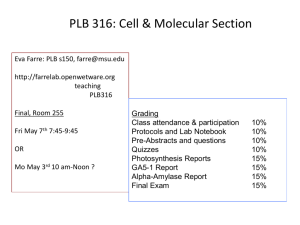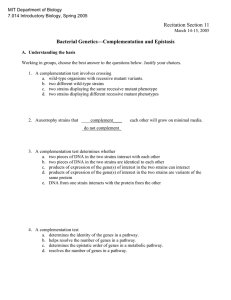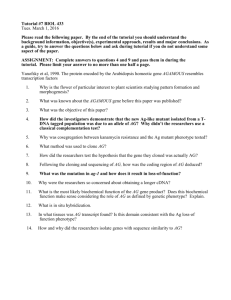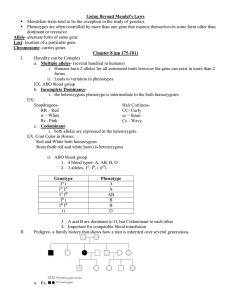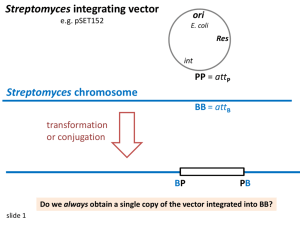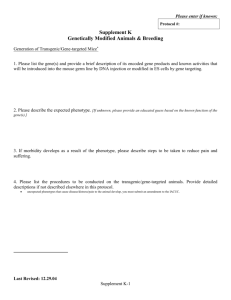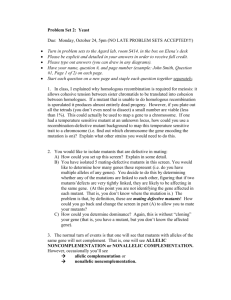Recitation Section 11 Answer Key Bacterial Genetics—Complementation and Epistasis
advertisement
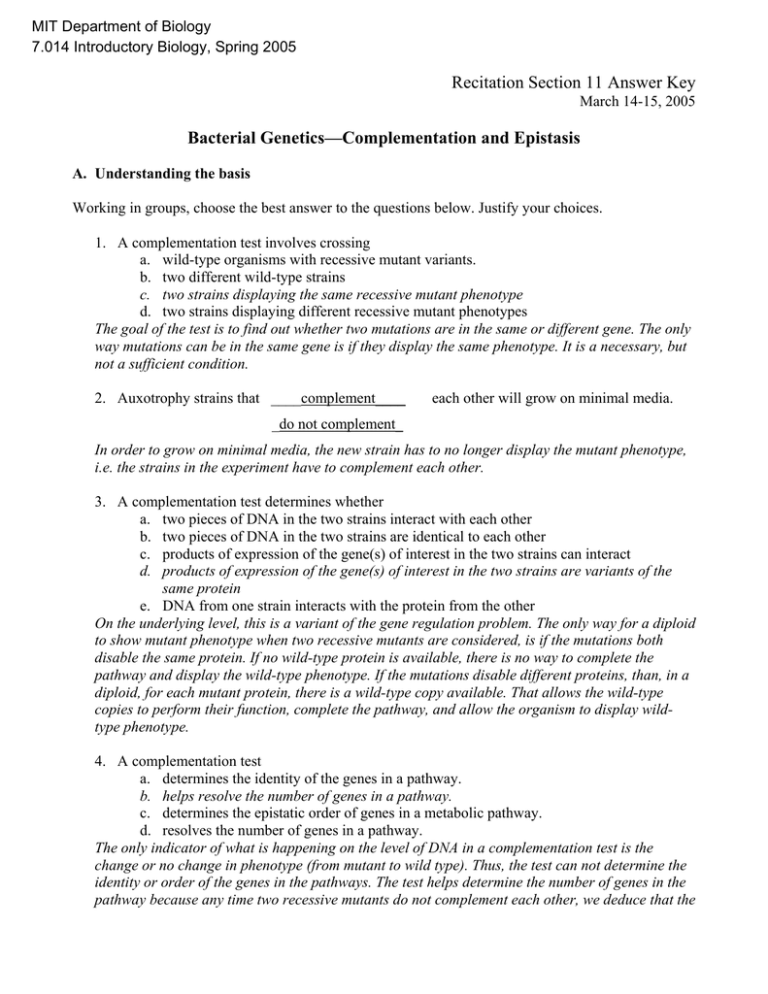
MIT Department of Biology 7.014 Introductory Biology, Spring 2005 Recitation Section 11 Answer Key March 14-15, 2005 Bacterial Genetics—Complementation and Epistasis A. Understanding the basis Working in groups, choose the best answer to the questions below. Justify your choices. 1. A complementation test involves crossing a. wild-type organisms with recessive mutant variants. b. two different wild-type strains c. two strains displaying the same recessive mutant phenotype d. two strains displaying different recessive mutant phenotypes The goal of the test is to find out whether two mutations are in the same or different gene. The only way mutations can be in the same gene is if they display the same phenotype. It is a necessary, but not a sufficient condition. 2. Auxotrophy strains that ____complement____ each other will grow on minimal media. _do not complement_ In order to grow on minimal media, the new strain has to no longer display the mutant phenotype, i.e. the strains in the experiment have to complement each other. 3. A complementation test determines whether a. two pieces of DNA in the two strains interact with each other b. two pieces of DNA in the two strains are identical to each other c. products of expression of the gene(s) of interest in the two strains can interact d. products of expression of the gene(s) of interest in the two strains are variants of the same protein e. DNA from one strain interacts with the protein from the other On the underlying level, this is a variant of the gene regulation problem. The only way for a diploid to show mutant phenotype when two recessive mutants are considered, is if the mutations both disable the same protein. If no wild-type protein is available, there is no way to complete the pathway and display the wild-type phenotype. If the mutations disable different proteins, than, in a diploid, for each mutant protein, there is a wild-type copy available. That allows the wild-type copies to perform their function, complete the pathway, and allow the organism to display wildtype phenotype. 4. A complementation test a. determines the identity of the genes in a pathway. b. helps resolve the number of genes in a pathway. c. determines the epistatic order of genes in a metabolic pathway. d. resolves the number of genes in a pathway. The only indicator of what is happening on the level of DNA in a complementation test is the change or no change in phenotype (from mutant to wild type). Thus, the test can not determine the identity or order of the genes in the pathways. The test helps determine the number of genes in the pathway because any time two recessive mutants do not complement each other, we deduce that the mutations are in the same gene, and any time two mutants do complement, we deduce that they are in different genes. However, the only way we can be sure that results of the test give us the complete answer for the number of genes in a pathways is if each complementation group has a large number of members. This is the only way we could be sure that the sample of mutants being considered is truly representative of the underlying gene structure. If the groups are large, it is statistically less probable that some gene was not represented in the original group of mutants, and, therefore, did not generate a complementation group. 5. All organisms in the same complementation group have identical DNA sequence. T F Organisms in the same complementation group are mutant in the same gene. However, the mutations do not have to be identical. There are many ways to cause a loss of function mutation in a gene. These different mutants would still display the same phenotype. 6. All organisms in the same complementation group have identical protein content and structure. T F The different mutations in the same gene can lead to vastly different proteins or no protein produced. But the overall phenotype will still be the same. 7. If gene A is epistatic to gene B then the AB double mutant has the a. phenotype conferred by the allele of gene A. b. phenotype conferred by the allele of gene B. c. wild-type phenotype. d. mutant phenotype at all times. Epistasis test determines the earliest point of breaking of a pathway. If the first mutation occurs, it essentially does not matter for the phenotype whether the second mutation is there or not. B. Complementation I. Example 1—Phe pathway Consider the following hypothetical pathway for the synthesis of the amino acid phenylalanine. • compound 1 is converted to compound 2 by enzyme A encoded by the pheA gene • compound 2 is converted to phenylalanine by enzyme B encoded by the pheB gene 1 ⎯⎯A⎯ ⎯→ 2 ⎯⎯B⎯→ phenylalanine You also have mutants, p1 through p5. These mutants cannot synthesize phenylalanine and thus cannot grow without addition of phenylalanine. • p1, p2, and p4 are in gene pheA • p3 and 5 are in pgene pheB 1. Suppose that you construct a diploid strain which contains both mutations, p1 and p2. Assuming that the phenotype associated with each of these mutations is recessive to wild type (one good copy of a gene is sufficient for wild-type phenotype), predict the phenotype of this diploid? In this case, since p1 is pheA– pheB+ and p2 is pheA– pheB+ the genotype of the diploid is: pheA – pheB + pheA – pheB + There are no good copies of the pheA gene, so no pheA protein will be produced, so the resulting diploid will be unable to synthesize phenylalanine (phe–). 2. Suppose that you construct a diploid strain which contains both mutations p1 and p3. Assuming that the phenotype associated with each of these mutations is recessive to wild type (one good copy of a gene is sufficient for wild-type phenotype), predict the phenotype of this diploid? In this case, since p1 is pheA– pheB+ and p3 is pheA+ pheB– the genotype of the diploid is: pheA – pheB + pheA + pheB – There are good copies of both the pheA gene and the pheB gene, so both pheA and pheB proteins will be produced, so the resulting diploid will be able to synthesize phenylalanine (phe+). 3. Based on your answers to parts (1) and (2) complete the following chart. • Put a “+” in the box if the resulting diploid can synthesize phenylalanine (wild-type phenotype) • Put a “–” in the box if the resulting diploid cannot synthesize phenylalanine (mutant phenotype) p1 p2 p3 p4 p5 wt p1 – p2 – – p3 + + – p4 – – + – p5 + + – + – wt + + + + + + 4. Suppose you had a mutation, p6, in gene pheA that had a dominant phenotype, i.e. a diploid p6 with this genotype: is unable to synthesize phenylalanine. Complete the following chart as + above: p6 p1 – p2 – p3 – p4 – p5 – p6 – wt – Given only this completed chart, could you determine whether p6 is mutant in pheA or pheB? From this chart it is impossible to tell if p6 is in gene pheA or gene pheB; in either case, the results would be the same. I. Example 2—Lysis pathway You are studying a bacteriophage and trying to determine how many genes are required for the phage to infect and lyse the host bacterium. You have eight mutants, all of which are unable to lyse a particular host bacterium. (Note: there must be another host that can be lysed by these mutants, otherwise, you couldn't grow them!) You perform pairwise infections with each of your mutant bacteriophage strains and get the following results: (+) = pair of phages lysed host cells, (-) = pair of phages failed to lyse host cells. m1 m2 m3 m4 m5 m6 m7 m8 wt m1 - m2 + - m3 + + - m4 + + - m5 + + - m6 + + + + - m7 + + + + - m8 + + + + - wt + + + + + + + + + 5. What are the complementation groups and how many genes have you identified? There are 3 complementation groups identifying 3 genes: m1, m4, and m5 are in gene 1 m2 is in gene 2 m3, m6, m7, and m8 are in gene 3 C. Epistasis I. Example 1—A pathway Given the following pathway for the synthesis of the essential compound A, where letters represent intermediate compounds and numbers represent enzymes: enzyme 1 X 2 Y Z 3 A intermediate compound Mutants with defective genes 1, 2, or 3 (m1, m2, m3) will require A to grow on minimal medium. 1. What intermediate will build up in the following mutants: m1:X m2:Y m3:Z 2. What intermediate(s) will the following mutants grow on? m1: Y, Z, or A m2:Z or A m3:A only 3. What intermediate will build up in the following double mutants? m2,m3:Y m1,m3:X m1,m2:X When ordering genes in biochemical pathways based on the build up of intermediates the observed phenotype is conferred by the gene that comes earlier in the pathway. 4. What intermediate(s) will the following double mutants grow on? m2,m3: A m1,m3: A m1,m2: Z or A When ordering genes in biochemical pathways based on feeding requirements for growth, the observed phenotype is conferred by the gene that comes later in the pathway. II. Example 2—Arg pathway You are studying the biosynthesis of the amino acid arginine. You have strians (m1, m2, m3, m4) with mutations in four different genes. You can add as a supplement to the medium three potential intermediates (A, B, C). You plate your strains on plates with the following media and see if they grow (+) or not (-). Strain wild-type m1 m2 m3 m4 Medium min min +A +B + + + + + + + min + - min +C + + min + arg + + + + + 5. What is the order of enzymes and intermediates in the pathway? The pathway is: 4 3 C 2 1 A B arginine 6. What supplement(s) would the double mutant m1,m4 grow on? m1,m4 would grow on B or arginine. III. Example 3—pigment synthesis You are studying the pathway of pigment synthesis in the fictitious bacterium, Bacterium colorificus. Wild-type bacteria are red. You have three mutant strains, with altered colors. Below is the chart of the wild type, three original mutants, and three double mutants: Genotype m1+ m2+ m3+ m1- m2+ m3+ m1+ m2- m3+ m1+ m2+ m3- m1- m2- m3+ m1+ m2- m3- m1- m2+ m3- Color Phenotype red (wild-type) orange yellow colorless orange colorless colorless 7. Based on this information, determine the order of the enzymes and intermediates in this pathway. The pathway is: colorless compound 3 orange compound 1 yellow compound 2 red compound
